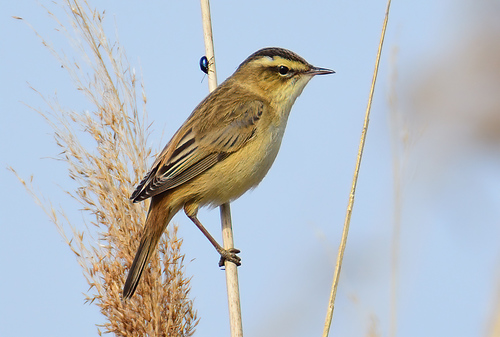
Sedge Warbler
The Sedge Warbler ( *Acrocephalus schoenobaenus*) is a small, migratory songbird known for its complex and varied song, often delivered from reedbeds and other dense vegetation. It plays a vital role in its ecosystem as an insectivore, helping to control insect populations. While not globally threatened, it faces challenges from habitat loss and degradation in parts of its range. The species' scientific name, *schoenobaenus*, refers to its preference for reedy habitats (schoenus meaning "reed" or "rush" and baino meaning "to walk" or "to tread").
11.5-13 cm
Length
17-21 cm
Wingspan
Least Concern
Conservation Status
Distribution
The Sedge Warbler breeds across Europe and western and central Asia. It is a long-distance migrant, wintering in sub-Saharan Africa. Its migratory route spans a vast distance, with birds traveling thousands of kilometers between breeding and wintering grounds.
Lifespan
The average lifespan in the wild is about 2 years, although some individuals can live longer.
Sedge Warbler's Habitat
Habitat Types
Reedbeds, Marshes, Wet grasslands, Fens, Areas with dense, low vegetation near water
Climate Zones
Temperate, Boreal
Adaptations
Sedge Warblers are well-adapted to life in dense vegetation. Their slender bodies and strong legs allow them to move easily through reeds and grasses. Their relatively short, rounded wings are suited for maneuverability in this environment rather than sustained high-speed flight.
Variations
While several subspecies have been proposed, there is little clear geographic variation, and *Acrocephalus schoenobaenus* is generally considered monotypic.
Appearance
Breeding Plumage
Plumage is similar in breeding and non-breeding seasons. The upperparts are warm brown with dark streaks, while the underparts are pale buff. A prominent feature is the pale supercilium (eyebrow stripe).
Seasonal Feather Changes
Minor. Freshly molted birds in autumn may appear slightly brighter.
Sex Based Plumage Differences
Males and females have very similar plumage.
Notable Features
Prominent pale supercilium, Dark streaks on the back and crown, Unstreaked, pale buff underparts, Rounded tail
Diet and Feeding
Primary Foods
Insects, Spiders, Small invertebrates, Berries (occasionally, especially during migration)
Foraging Behavior
Sedge Warblers are active foragers, gleaning insects from leaves and stems within dense vegetation. They often hop and flit through reeds and other plants, picking off prey. They may also make short flights to catch flying insects.
Specializations
Their fine bill is well-suited for picking small insects from vegetation.
Seasonal Diet Variations
The diet is primarily insectivorous during the breeding season. During migration and in the wintering grounds, they may supplement their diet with berries and other fruits when available.
Behavior
Social Structure
Sedge Warblers are generally solitary or found in pairs during the breeding season. Outside of the breeding season, they may form small, loose flocks, especially during migration.
Communication
Complex and varied song (males), Chattering calls, Alarm calls
Migration
Sedge Warblers are long-distance migrants, traveling between Europe/Asia and sub-Saharan Africa. They migrate at night, navigating using a combination of celestial cues, the Earth's magnetic field, and possibly visual landmarks.
Territorial or Group Behaviors
Males are territorial during the breeding season, defending their territory from other males through song and aggressive displays. Territories are relatively small, focused on areas with suitable nesting habitat.
Conservation
Threats
Habitat loss and degradation (drainage of wetlands, agricultural intensification), Climate change (affecting migration timing and food availability), Pesticide use (reducing insect prey)
Protection Programs
Habitat restoration and management projects, International agreements on migratory species (e.g., AEWA)
Local National Laws
Protected under various national and international wildlife laws.
Population Trend
Decreasing
Population Estimates
The global population is estimated to be between 11,300,000 and 20,800,000 mature individuals.
Interesting Facts
Sedge Warblers are known for their impressive song mimicry.
Males can incorporate the songs of other bird species into their own repertoire, creating a complex and varied song.
They are remarkably faithful to both breeding and wintering sites.
Individuals often return to the same areas year after year.
They have a relatively high wing-loading.
This, along with their rounded wings, limits their ability to soar and favors short bursts of flight.
Faqs about Sedge Warbler
What is the difference between a Sedge Warbler and a Reed Warbler?
Sedge Warblers have a prominent pale supercilium (eyebrow stripe) and a streaked back, while Reed Warblers are plainer and have a less distinct supercilium.
Where can I see a Sedge Warbler?
Look for Sedge Warblers in reedbeds, marshes, and other areas with dense, low vegetation near water, particularly during the breeding season (May-July in Europe).
How long do Sedge Warblers live?
The average lifespan is about 2 years, although some individuals can live longer.
Are Sedge Warblers endangered?
No, the Sedge Warbler is classified as Least Concern by the IUCN, but populations are declining due to various threats.
Copyright @ Nature Style Limited. All Rights Reserved.
 English
English